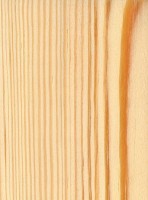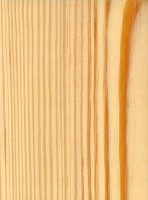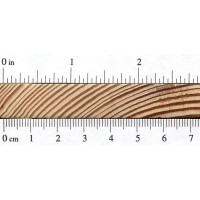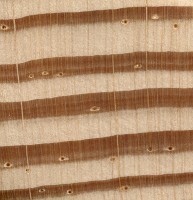 |
Common Name(s): Caribbean Pine
Scientific Name: Pinus caribaea Distribution: Central America and the Caribbean; also grown on plantations worldwide Tree Size: 65-100 ft (20-30 m) tall, 2-3 ft (.6-1 m) trunk diameter Average Dried Weight: 39 lbs/ft3 (625 kg/m3) Specific Gravity (Basic, 12% MC): .51, .63 Janka Hardness: 1,110 lbf (4,920 N) Modulus of Rupture: 13,340 lbf/in2 (92.0 MPa) Elastic Modulus: 1,745,000 lbf/in2 (12.03 GPa) Crushing Strength: 7,890 lbf/in2 (54.4 MPa) Shrinkage:Radial: 6.3%, Tangential: 7.8%, Volumetric: 12.9%, T/R Ratio: 1.2 |
Color/Appearance: Heartwood is reddish brown, sapwood is yellowish white and is distinct from the heartwood.
Grain/Texture: Straight grained with a medium to coarse texture and a greasy feel.
Endgrain: Large resin canals, numerous and evenly distributed, mostly solitary; earlywood to latewood transition abrupt, color contrast high; tracheid diameter medium-large.
Rot Resistance: The heartwood is rated as moderately resistant to decay.
Workability: Overall, Caribbean Pine works fairly well with most tools, though the resin can gum up tools and clog sandpaper. Caribbean Pine glues and finishes well.
Odor: Caribbean Pine has a strong resinous odor while being worked.
Allergies/Toxicity: Working with pine has been reported to cause allergic skin reactions and/or asthma-like symptoms in some people. See the articles Wood Allergies and Toxicity and Wood Dust Safety for more information.
Pricing/Availability: Caribbean Pine is an important commercial species which is widely grown on plantations worldwide. Caribbean Pine should be available throughout its native range for a modest price.
Sustainability: This wood species is not listed in the CITES Appendices, and is reported by the IUCN as being a species of least concern.
Common Uses: Paper (pulpwood), veneer, plywood, flooring, and construction lumber.
Comments: Although not technically a southern yellow pine, Caribbean Pine is closely related to other pine species found in southeastern United States which are commonly grouped as southern yellow pine, such as Longleaf, Shortleaf, Loblolly, and Slash Pine.
- Austrian Pine (Pinus nigra)
- Eastern White Pine (Pinus strobus)
- Jack Pine (Pinus banksiana)
- Jeffrey Pine (Pinus jeffreyi)
- Khasi Pine (Pinus kesiya)
- Limber Pine (Pinus flexilis)
- Loblolly Pine (Pinus taeda)
- Lodgepole Pine (Pinus contorta)
- Longleaf Pine (Pinus palustris)
- Maritime Pine (Pinus pinaster)
- Ocote Pine (Pinus oocarpa)
- Patula Pine (Pinus patula)
- Pinyon Pine (Pinus edulis)
- Pitch Pine (Pinus rigida)
- Pond Pine (Pinus serotina)
- Ponderosa Pine (Pinus ponderosa)
- Radiata Pine (Pinus radiata)
- Red Pine (Pinus resinosa)
- Sand Pine (Pinus clausa)
- Scots Pine (Pinus sylvestris)
- Shortleaf Pine (Pinus echinata)
- Slash Pine (Pinus elliottii)
- Spruce Pine (Pinus glabra)
- Sugar Pine (Pinus lambertiana)
- Sumatran Pine (Pinus merkusii)
- Table Mountain Pine (Pinus pungens)
- Western White Pine (Pinus monticola)
- Virginia Pine (Pinus virginiana)
Scans/Pictures: There are currently no pictures of this exact wood species, but a similar species within the Pinus genus is being substituted (P. palustris). If you’d like to contribute a wood sample of this specific species to be scanned, (even small pieces of veneer can be sent), please use the contact form.







